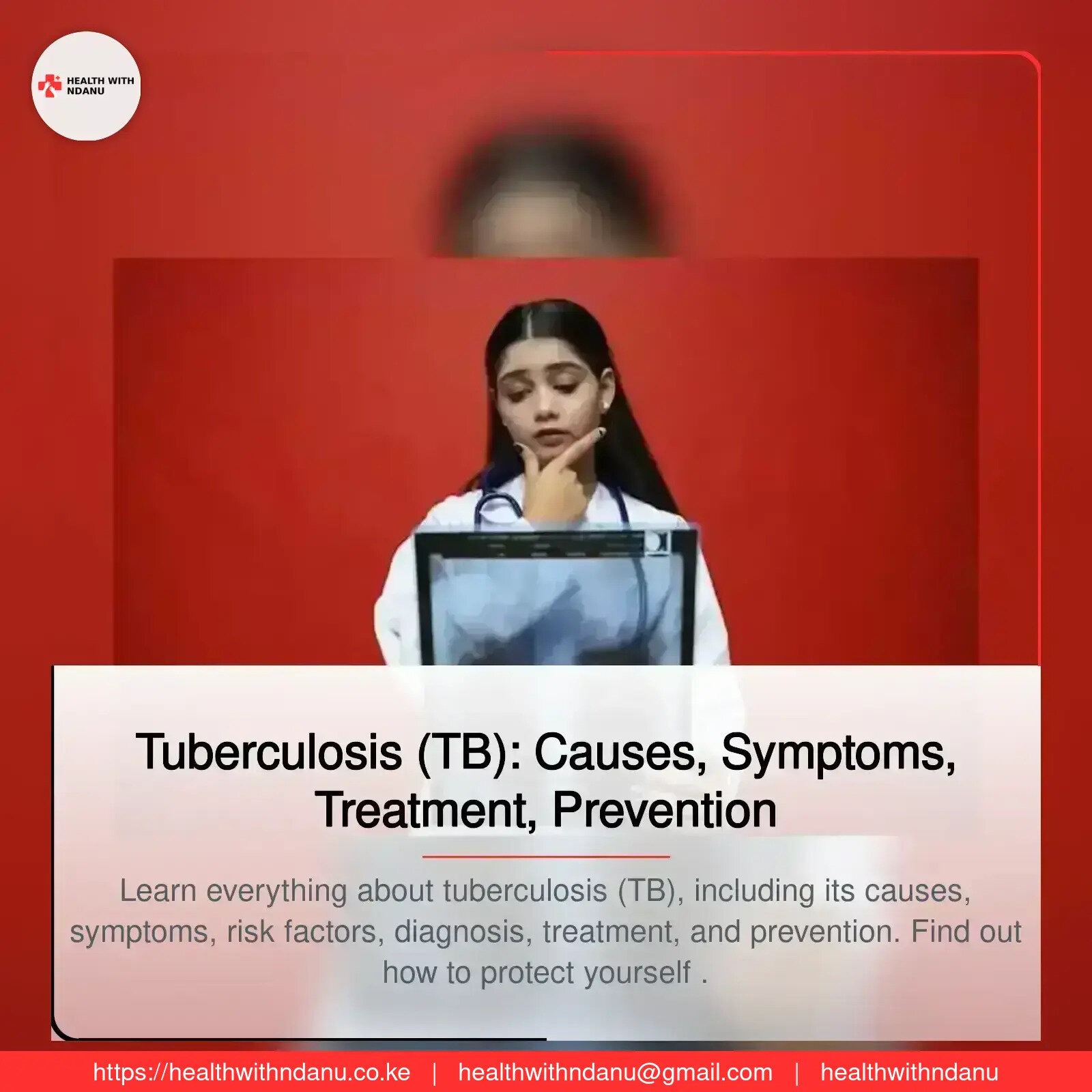Tuberculosis (TB): Causes, Symptoms, Treatment, Prevention
- by Diana Ndanu
- 25 March, 2025
- 0 Comments
- 6 Mins



Introduction to Tuberculosis (TB)
Tuberculosis (TB) is a bacterial infection caused by Mycobacterium tuberculosis. It primarily affects the lungs but can also spread to other parts of the body, such as the bones, brain, kidneys, and spine. TB remains a global health threat, causing millions of infections and deaths each year.
Despite being preventable and treatable, tuberculosis continues to be a major concern, especially in developing countries. Understanding its causes, symptoms, treatment, and prevention is crucial for controlling its spread.
This article covers everything you need to know about tuberculosis, including risk factors, how it spreads, available treatments, and ways to protect yourself.
Causes and Transmission of Tuberculosis
What Causes TB?
Tuberculosis is caused by Mycobacterium tuberculosis, a bacterium that spreads through the air when an infected person coughs, sneezes, laughs, or speaks. The bacteria can remain suspended in the air for hours, increasing the risk of infection in crowded or poorly ventilated spaces.
How Does TB Spread?
TB spreads from person to person through airborne droplets. However, it does not spread through:
- Shaking hands
- Sharing food or drinks
- Touching surfaces
- Casual contact with an infected person
To get infected, you typically need prolonged exposure to someone with active TB. However, not everyone who is exposed to the bacteria will develop the disease.
Latent TB vs. Active TB
- Latent TB: The bacteria remain in the body without causing symptoms. A person with latent TB is not contagious but may develop active TB later.
- Active TB: The bacteria multiply and cause symptoms. This form of TB is contagious and requires immediate treatment.
Symptoms of Tuberculosis
TB symptoms vary depending on which part of the body is affected. However, the most common form—pulmonary TB (affecting the lungs)—has the following symptoms:
Common Symptoms of Pulmonary TB
- Persistent cough lasting more than three weeks
- Coughing up blood or mucus
- Chest pain
- Difficulty breathing
- Fatigue and weakness
- Unexplained weight loss
- Fever and night sweats
- Loss of appetite
Symptoms of Extrapulmonary TB
When TB affects other parts of the body, symptoms depend on the infected organ:
- TB of the bones: Joint pain and bone deformities
- TB of the kidneys: Blood in urine and back pain
- TB of the brain (tuberculous meningitis): Severe headache, confusion, and seizures
- TB of the lymph nodes: Swelling in the neck or armpits
- If you experience any of these symptoms, seek medical attention immediately.
Risk Factors for Tuberculosis
Certain factors increase the risk of developing TB, including:
Weakened Immune System
People with weakened immune systems are more susceptible to TB, including:
- Individuals with HIV/AIDS
- Cancer patients undergoing chemotherapy
- People with diabetes
- Organ transplant recipients on immunosuppressive drugs
- Close Contact with an Infected Person
- Living or working in close quarters with someone who has active TB increases the risk of infection. This includes:
- Family members of TB patients
- Healthcare workers
- Prison inmates
Malnutrition and Poor Living Conditions
- Malnutrition weakens the immune system, making it easier for TB bacteria to take hold. People living in overcrowded and poorly ventilated areas also face higher risks.
Substance Abuse and Smoking
- Smoking damages lung tissue, making it easier for TB bacteria to multiply.
- Excessive alcohol and drug use weaken the immune system.
Diagnosis of Tuberculosis
TB can be diagnosed using several tests, depending on symptoms and risk factors.
Common TB Diagnostic Tests
1. Tuberculin Skin Test (TST) / Mantoux Test
- A small amount of tuberculin is injected into the skin.
- If a raised bump appears after 48-72 hours, the person may have been exposed to TB.
- This test cannot distinguish between latent and active TB.
2. Chest X-ray
- Helps detect lung abnormalities caused by TB.
3. Sputum Test (Microscopy & Culture)
A sample of mucus from the lungs is examined under a microscope to detect TB bacteria.
4. Interferon-Gamma Release Assays (IGRAs)
- Blood tests that detect TB infection.
- More accurate than the Mantoux test.
5. CT Scan & MRI
- Used for diagnosing extrapulmonary TB.
- Early diagnosis is crucial to prevent the spread of TB and start timely treatment.
Tuberculosis Treatment
TB is treatable with a combination of antibiotics. However, treatment must be followed strictly to prevent drug resistance.
First-Line Treatment for TB
- Rifampicin
- Isoniazid
- Ethambutol
- Pyrazinamide
These drugs are taken for six months in a specific combination prescribed by a doctor. Stopping treatment early can lead to drug-resistant TB.
Multidrug-Resistant TB (MDR-TB)
When TB bacteria become resistant to first-line drugs, stronger antibiotics are required. MDR-TB is harder to treat and requires longer, more toxic treatments.
Extensively Drug-Resistant TB (XDR-TB)
A rare but serious form of TB resistant to most available drugs. Treatment is complex and expensive.
Tuberculosis Prevention
Preventing TB involves vaccination, early detection, and good hygiene practices.
1. BCG Vaccine
The Bacillus Calmette-Guérin (BCG) vaccine is given to infants in countries where TB is common. It protects against severe forms of TB but is not 100% effective.
2. Preventing TB Spread
- Wear a mask if you have active TB.
- Cover your mouth when coughing or sneezing.
- Improve ventilation in indoor spaces.
- Take prescribed medication completely to prevent resistance.
3. TB Preventive Therapy (TPT)
People with latent TB, especially those with weakened immune systems, can take preventive medication to stop TB from becoming active.
4. Healthy Lifestyle
A strong immune system helps fight infections. Maintain a healthy diet, exercise regularly, and avoid smoking and excessive alcohol consumption.
Global Impact of Tuberculosis
TB Statistics
- Over 10 million people contract TB annually.
- 1.5 million deaths occur each year, making TB one of the deadliest infectious diseases.
- Drug-resistant TB is a growing concern, requiring urgent action.
TB in High-Risk Countries
TB is more prevalent in India, China, South Africa, Indonesia, and Nigeria. Poor healthcare systems, poverty, and malnutrition contribute to high TB rates.
Efforts to Eliminate TB
The World Health Organization (WHO) aims to end TB by 2035 through:
- Better TB testing and treatment.
- Improved vaccines.
- Public awareness campaigns.
Conclusion
Tuberculosis is a preventable and treatable disease, yet it continues to affect millions worldwide. By understanding its symptoms, transmission, and treatment, we can reduce its spread and save lives.
If you experience TB symptoms, seek medical attention immediately. Follow preventive measures, complete your treatment, and spread awareness to help eliminate TB globally.
For more health articles, visit healthwithndanu.co.ke
Got Your Own Experience? Share with us
Popular Categories
Mablogu Zinazobambwa Sana
Daily Newsletter
Get all the top stories from Blogs to keep track.



